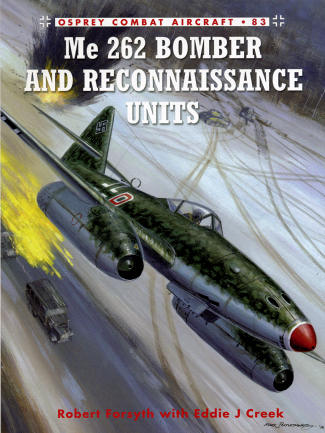 Number
83 in Osprey's Combat Aircraft series is on Me-262 bomber and recce units. We
have read quite a bit over the years on the fighter units that flew this
aircraft, but that was not the only type of unit that flew this revolutionary
aircraft.
Number
83 in Osprey's Combat Aircraft series is on Me-262 bomber and recce units. We
have read quite a bit over the years on the fighter units that flew this
aircraft, but that was not the only type of unit that flew this revolutionary
aircraft.|
Author: |
Robert Forsyth with Eddie Creek |
|
Publisher/Distributor |
Osprey Publishing |
|
Price |
$22.95 MSRP |
|
Reviewer: |
|
| Notes: |
96 pages, 7¼ x 9¼ inches, softbound ISBN: 1-84908-749-0 |
 Number
83 in Osprey's Combat Aircraft series is on Me-262 bomber and recce units. We
have read quite a bit over the years on the fighter units that flew this
aircraft, but that was not the only type of unit that flew this revolutionary
aircraft.
Number
83 in Osprey's Combat Aircraft series is on Me-262 bomber and recce units. We
have read quite a bit over the years on the fighter units that flew this
aircraft, but that was not the only type of unit that flew this revolutionary
aircraft.
In fact, once Hitler saw the jet and its performance, he pretty well insisted that the aircraft be produced as a bomber. Not wanting to incur the wrath of fearless leader, Messerschmitt basically told him 'No problem'. Of course, it was a problem as the plane had not been designed to carry bombs. It meant adding bomb racks and reinforcing the forward fuselage to handle them. It also required adding fuel as the plane was expected to carry out missions over a relatively long range with a rather heavy load (500 kg). An extra fuel tank was installed in the fuselage behind the pilot, but this upset the center of gravity once the bomb load was released so pilots had to be very careful about not stalling the plane after release. There was also no bomb sight developed for the aircraft and most bombing was done in a shallow dive from rather high altitudes. Most missions do not report any results and I have a feeling that most bombs dropped were not very effective.
One area that was pretty successful was the development of the aircraft into a reconnaissance platform. The rather large cameras required some alteration to the old gun bay doors in order to fit two cameras. It also reduced the gun load to a single 30mm firing from the center of the nose. Like the bomber type that had to reduce nose guns from 4 to 2 due to weight, the same is true of the recce bird. A dedicated reconnaissance version, the 262A-1/U4 was developed, but most were standard A-1 fighters modified at various centers in Germany as the 262A-1/U3. As you might expect, it took a while to train a recce pilot to operate this system and fly this new aircraft so while their service was of great value to planners, there just were not enough of them to go around.
In this book by Forsyth and Creek, we get a look at the development of these two types. As they were developed concurrently, there is no separation during the telling of the story. And the story of the various missions flown by these aircraft is what fills most of the book. It is pretty much a day by day account of the use of both of these types from around the Normandy landing until the very end of the war, after most aircraft had been rebased in Czechoslovakia. We get the usual pilot stories that make this series so interesting as well as a look, though some superb period photos, of the men and the planes they flew. The book includes several pages of color profiles of these two aircraft, something that is usually of great interest to modelers. I was somewhat surprised at how similar many of these planes appeared. Most of the recce birds have an interesting scribble camouflage pattern that should be fun for modelers to duplicate.
In all, I found the book to be a superb read about an aspect of Me-262 operations that is rarely told. Most highly recommended.
September 2012
For more on the complete line of Osprey books, visit www.ospreypublishing.com or contact them at Osprey Direct, PO Box 140, Wellingborough, Northants, NN8 2FA, UK. In the US, it is Osprey Direct at 44-02 23rd St, Suite 219, Long Island City, NY 11101., where you can get a catalogue of available books.
If you would like your product reviewed fairly and quickly, please contact me or see other details in the Note to Contributors.